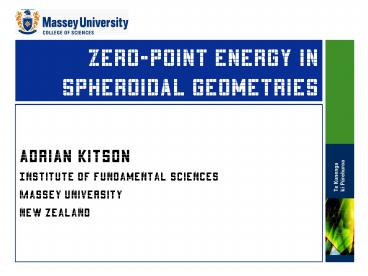ZeroPoint Energy in Spheroidal Geometries - PowerPoint PPT Presentation
1 / 27
Title:
ZeroPoint Energy in Spheroidal Geometries
Description:
Oblate spheroid (with b = 0.1) For fixed b and increasing a the ZPE again decreases. For large oblate ellipticity the ZPE is negative. a ... oblate ... – PowerPoint PPT presentation
Number of Views:212
Avg rating:3.0/5.0
Title: ZeroPoint Energy in Spheroidal Geometries
1
Zero-Point Energy in Spheroidal Geometries
- Adrian Kitson
- Institute of Fundamental Sciences
- Massey University
- New Zealand
2
Outline
- Motivation
- Spheroidal geometry
- Scalar field
- Vector field
- QCD flux tubes
3
Motivation
- Lattice QCD simulations
4
Spheroidal geometry
- Cartesian equation
- Prolate
- Oblate
- Ellipticity
- Prolate
- Oblate
z
b
y
a
x
5
Spheroidal geometry
- Prolate spheroidal coordinates
- where
z
b
y
a
x
6
Scalar field
- Consider a massless scalar field satisfying
Dirichlet boundary conditions on the surface of a
prolate spheroid - Assuming harmonic time dependence, , the
field equation becomes Helmholtzs equation - This can be solved by separation of variables in
prolate spheroidal coordinates
7
Radial function
- The radial function satisfies the following
differential equation - In the spherical limit this reduces
to - which is the spherical Bessel differential
equation with
8
Radial function
- For general c
- where
- The coefficients satisfy a
three-term recursion relation - The radial functions are normalized to have the
same asymptotic behaviour as the spherical Bessel
functions
9
Dirichlet boundary condition
- The Dirichlet boundary condition becomes
- In terms of dimensionless variables
- where e is the prolate ellipticity
- The eigen-energy modes are
10
Zeta-function approach
- The ZPE is defined as
- (though from now on let )
- Spectral zeta function
- The zeta-function approach defines the ZPE as
11
Zeta-function approach
- In terms of dimensionless variables
- This can be written as a contour integral
- This can be analytically continued to give
- which is valid for
12
Zeta-function approach
- For small ellipticity
- The first term is simply the zeta function for a
spherical boundary
13
Zeta-function approach
- Rescaling , and writing in terms of
Ricatti-Bessel functions - where and the Ricatti-Bessel
functions are
14
Bessel functions
- Uniform asymptotic expansion
- where and
15
Zeta-function approach
- Rescaling , and writing in terms of
Ricatti-Bessel functions - where and the Ricatti-Bessel
functions are
16
Zeta-function approach
- The coefficient of
- Using the uniform asymptotic expansion for the
Bessel functions the integrand is expanded to
17
Zeta-function approach
- Laurent expansion of the zeta function about
- The contribution to the ZPE from the coefficient
of - Including exterior modes gives
18
Greens function approach
- The Greens function for the scalar field
satisfies - If all space is considered, the zero-point energy
is given by - Working to , the contribution to the
ZPE from the coefficient of
19
Zero-point energy
- The zero-point energy of a massless scalar field
subject to Dirichlet boundary conditions on a
prolate spheroidal shell - The spherical part is taken from Romeos work on
the zeta-function approach in spherical
geometries 1 - 1 A. Romeo, Bessel ?-function approach to the
Casimir effect of a scalar field in a spherical
bag, Phys Rev D52 7308 (1995)
20
Results
- Prolate spheroid (with a 0.1)
- For fixed a, the ZPE of a scalar field subject
to prolate spheroidal boundary conditions
decreases as b increases
- Oblate spheroid (with b 0.1)
- For fixed b and increasing a the ZPE again
decreases - For large oblate ellipticity the ZPE is negative
a
b
21
Results
- ZPE of a scalar field subject to Dirichlet
boundary conditions on the surface of a spheroid
prolate
b
a
oblate
22
Vector field
- The vector Helmholtzs equation cannot be solved
by separation of variables in prolate spheroidal
coordinates - If axial symmetry is assumed, then the vector
field can be separated into transverse electric
(TE) and transverse magnetic (TM) modes - The boundary conditions are
23
Results
- ZPE of an axially symmetric electromagnetic field
inside a perfectly conducting prolate spheroidal
cavity
a 0.1
b
24
QCD flux tubes
- Oxman et al. found for an infrared modified gluon
bag model the ZPE of a spherical bag is
attractive 2 - For an infrared modified propagator the
zero-point energy is - Assuming the above relation, and accounting for
the 8 gluons, the QCD ZPE for a prolate
spheroidal cavity is - 2 L. E. Oxman, N. F. Svaiter R. L. P.G.
Amaral, Attractive Casimir effect in an infrared
modified gluon bag model, hep-th/0507195 (2005)
25
Results
- ZPE of QCD flux tube?
a 0.1
26
Summary
- The zero-point energy of scalar fields in
spheroidal geometries can be calculated for small
ellipticity - Vector fields in spheroidal geometries are more
of a challenge - Assuming the infrared modified result, the ZPE of
a QCD flux tube gives rise to an attractive
inter-quark force
27
Acknowledgments
- Prof. Tony Signal
- Massey University
- Institute of Fundamental Sciences and the Royal
Society of New Zealand - QFEXT05 Organizing committee

